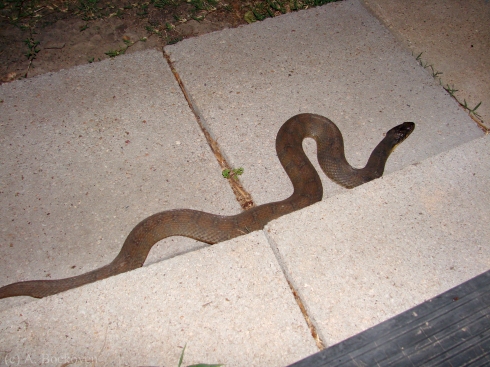Ah, Texas summers. Heat like a broiling pot and air conditioning bills that could eat you alive. In honor of this lovely change of season (there’s a brief week where the nights still get below 80) I left my back door open the other night to help cool off the house. All sorts of wildlife too this as an invitation to drop by and say Hi. Aside from the the junebugs who spent the evening dive bombing my computer screen I saw a variety of nocturnal insects, including the charismatic fellow above. I found this adult antlion perched in my bathroom, apparently checking himself out in the mirror. I have seen exactly four of these locally in the past year, so apparently I should consider leaving my back door open more often. All the fun of collecting in the comfort of my own home!
This wasn’t my most exciting visitor, however. The real fun was when I came by the back door to find my dog having a stare down with a large snake.
I don’t normally freak out over snakes (I spent a summer catching copperheads for a field project) but I also don’t normally find strange ones trying to enter my home. Turns out I find this kind of unnerving. Especially when the porch light is out and all I can see is a large dark shape. This leaves the ‘can it kill me?’ question wide open here in Texas. Of course, my first reaction was still to tell my dog to stay while I ran to grab the camera. Some instincts run deep.
The flash had the added bonus of lighting up the patterning, revealing it to be a water snake. Mean tempered, but not venomous.
Best exchange when I told this story:
Mom: What did you do with it?
Me: I closed the door?
All in all, a fun evening.


















Recent Comments